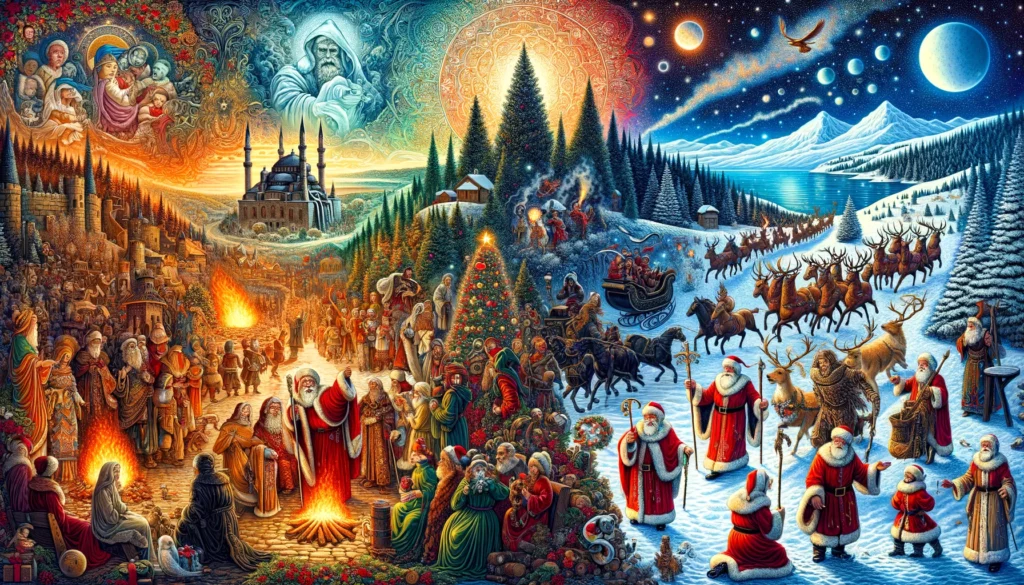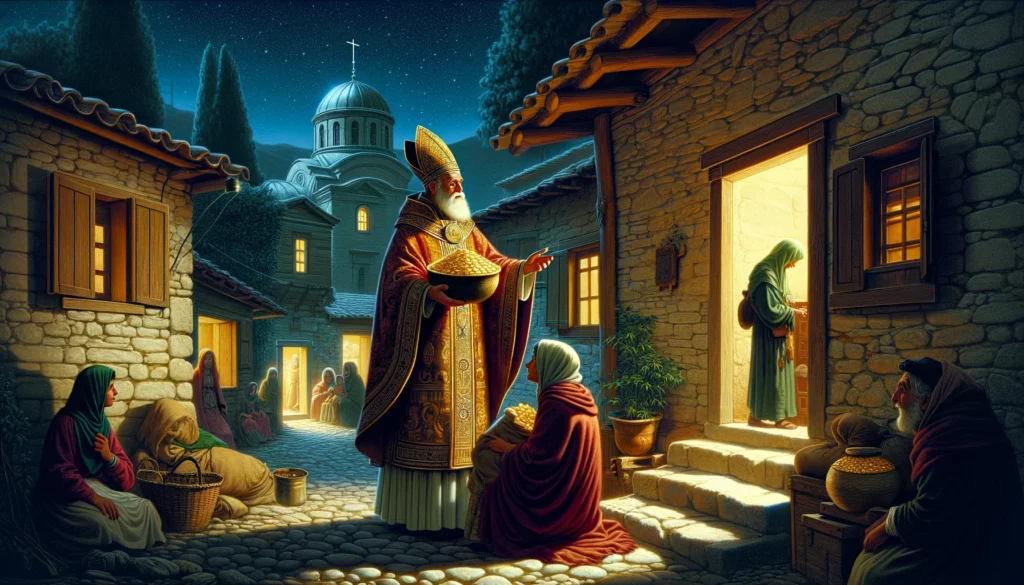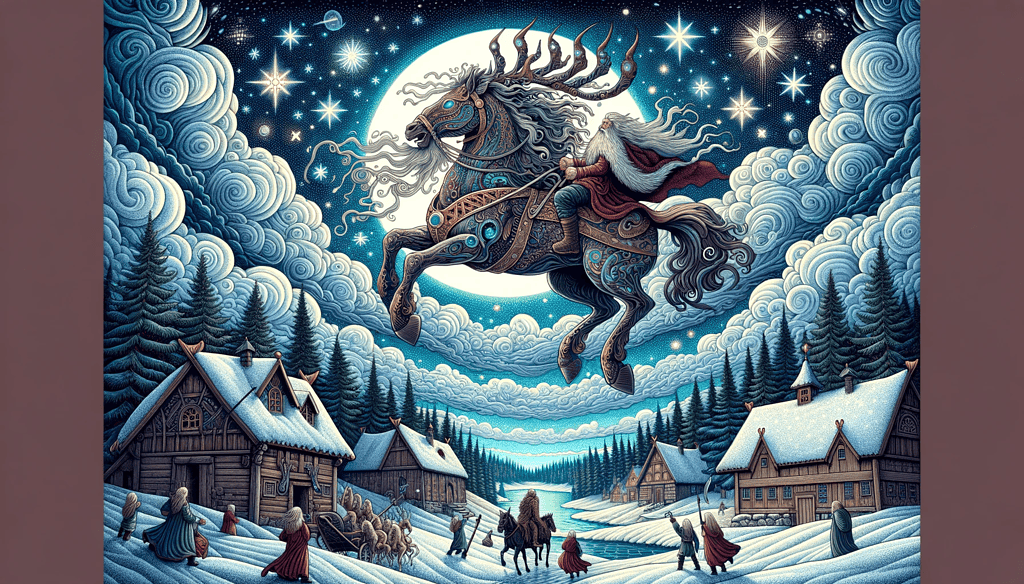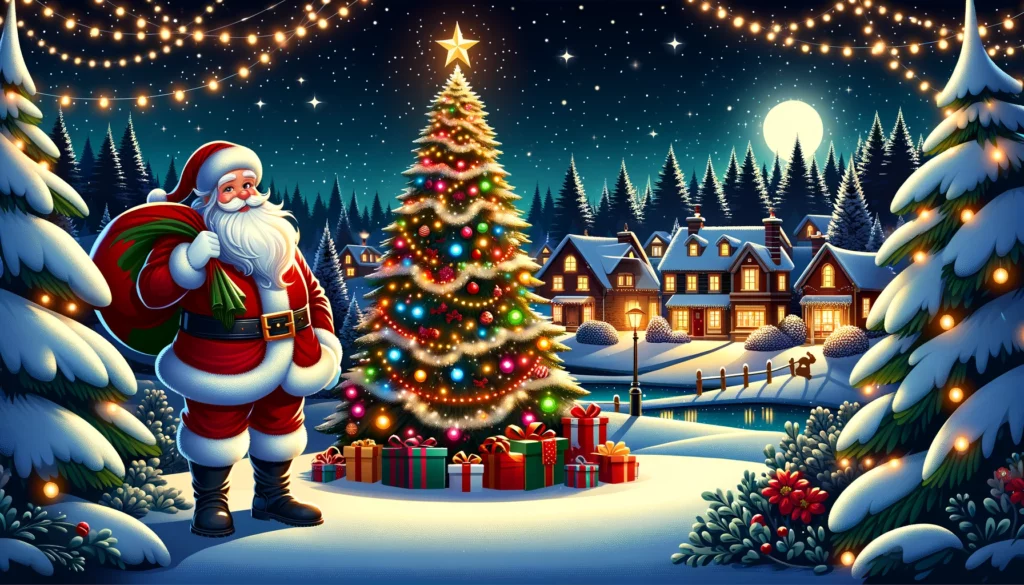
Santa Claus: a name that resonates with joy, magic, and mystery in the hearts of millions around the world. The image of this jolly figure in red, standing beside a brightly lit Christmas tree, has come to symbolize the spirit of Christmas in countless homes. But who is this character and how has he come to be so central to our celebrations?
Let’s explore some of the folklore behind Santa and unravel the threads of history, myth, cultural evolution, and traditions that have woven the fascinating tapestry of Santa Claus’s legend.
The Ancient Roots of Santa Claus
The roots of the Santa Claus legend can be traced back to a historical figure: Saint Nicholas of Myra. Saint Nicholas lived in the 4th century in what is now modern-day Turkey and was renowned for his piety and generosity. His most famous act, secretly delivering gold to save a poor man’s daughters from destitution, became emblematic of his legacy. This act of giving, done in secret and out of pure kindness, set the foundation for the Santa Claus myth.

While Saint Nicholas is a cornerstone, the Santa Claus myth is also heavily influenced by a variety of pagan traditions. In pre-Christian times, many European cultures celebrated the winter solstice by adorning trees with ornaments and lighting massive bonfires, as well as blending magic, spirits, and gods. Perhaps the most famous ones are the Roman Saturnalia and the Germanic or Norse Yuletime. These celebrations also celebrated pagan deities — most notably, the Norse god Odin.
Odin was the “Allfather”, the most powerful god in Norse mythology. There are plenty of myths surrounding Odin. For instance, the god was said to lead a ghostly procession (the Wild Hunt) in the sky during the Yule period when families gathered around their Christmas tree. This was said to bring bad luck to whoever saw it — but Odin was also a gift giver in some myths. So his folklore started intertwining with Saint Nicholas and ultimately, may have merged into Santa Claus.
This amalgamation of Christian and pagan elements was a common strategy in early Christianity to make the new religion more palatable to pagan converts.

Different Names for Santa Claus From Around the World
Santa Claus seems like one single mythological figure. But there are actually different Santa myths in different cultures.
The Finnish Yule Goat
In Finland, Joulupukki, or “Yule Goat,” is a Christmas figure who delivers presents. Originating from an old pagan tradition, Joulupukki was initially a scary character who demanded presents from people, quite a unique ingredient in the global Christmas fairy tale. Over time, he transformed into a more benevolent figure resembling Santa Claus, delivering gifts instead of asking for them – a much awaited something for the Finnish children and adults alike.
Father Christmas: England’s Yuletide Figure
In many Hispanic cultures, the Three Wise Men or the Three Kings play the role of gift-givers. Children leave their shoes out on the night of January 5th, filled with hay for the kings’ camels. By morning, the hay is replaced with gifts, celebrating the Three Kings’ visit to the baby Jesus.
Sinterklaas: The Dutch Forerunner
Fast forward to the Middle Ages, and Saint Nicholas had become a popular saint in Europe. In the Netherlands, he evolved into Sinterklaas, a kindly old man who delivered gifts on the eve of his feast day. Dutch settlers brought this tradition to America in the 17th century, where Sinterklaas would eventually become Santa Claus, adding another beautiful element to the fairy tale of Christmas, much to the delight of children and adults alike.
Washington Irving, a writer, was among the first to reimagine the Dutch Sinterklaas as a jolly, pipe-smoking figure in his 1809 book, “A History of New York.” This reimagining set the stage for further evolution of the Santa Claus figure.
Ded Moroz: Russia’s Frosty Gift-Giver
Ded Moroz, translated as “Father Frost,” is a traditional Slavic folklore figure similar to Santa Claus, primarily known in Russia and parts of Eastern Europe. Unlike the jolly, red-suited Santa, Ded Moroz often appears in a long, flowing robe which is frequently blue or silver, symbolizing the cold winter. His role in holiday festivities is akin to that of Santa Claus, as he brings presents to children, but his delivery time is traditionally on New Year’s Eve rather than Christmas Day. He is often accompanied by his granddaughter, Snegurochka, or “Snow Maiden,” who helps him distribute gifts.
Julenisse: Scandinavia’s Christmas Elves
In Scandinavian folklore, the Julenisse are elves or gnomes who are associated with the winter solstice and Christmas season. Traditionally, they are thought to protect families and adults, and in modern times, they have taken on a role similar to Santa Claus, delivering gifts.
Mikulás: Hungary’s Gift-Bringer
Celebrated on December 6th, St. Nicholas Day, Mikulás visits children, rewarding those who have been good throughout the year. On the eve of December 5th, children clean and polish their boots, placing them on windowsills or doorsteps, eagerly anticipating Mikulás’ arrival. Overnight, Mikulás fills these boots with treats — typically sweets, fruits, nuts, and small toys — for well-behaved children. Those who have misbehaved might find a golden birch, a symbol for a warning or mild punishment, among their treats. Mikulás is often depicted as an elderly, kind-hearted man with a long white beard, dressed in a bishop’s robe and mitre, reflecting his origin as a Christian bishop. He sometimes is accompanied by Krampusz, a devilish figure who handles the naughty children, similar to Père Fouettard in French tradition.
Shengdan Laoren: China’s Christmas Old Man
In China, where Christmas is more of a commercial and cultural celebration than a religious one, Santa Claus is known as Shengdan Laoren, meaning “Christmas Old Man.” In this Eastern interpretation, he is often depicted in traditional red attire, bringing gifts and joy to children, embodying the universal ingredient of gift-giving in the global Christmas narrative.
Pierre Noël: France’s Christmas Figure
Père Noël, which literally translates to “Father Christmas,” is depicted similarly to Santa Claus, with a red suit and a white beard, delivering presents to children on Christmas Eve. According to French tradition, children place their shoes by the fireplace or under the Christmas tree on Christmas Eve. Père Noël fills these shoes with gifts and treats for well-behaved children. A unique aspect of the French tradition is the inclusion of Père Fouettard, a companion of Père Noël who provides spankings or coal to naughty children.
The Evolution of Santa Claus

The visual portrayal of Santa Claus was crystallized in the 19th century by Thomas Nast, an American cartoonist. His illustrations for Harper’s Weekly magazine featured a rotund, cheerful man with a full white beard, dressed in a red suit trimmed with white fur, reminiscent of the vibrant colors of a forest during fall. This image has become the definitive Santa Claus.
Literature also helped cement our image of Santa Claus.
In 1822, Clement Clarke Moore’s poem “A Visit from St. Nicholas” (commonly known as “‘Twas the Night Before Christmas”) further shaped the modern image of Santa Claus. The poem presented Santa akin to a magical creature from a winter’s forest. Moore’s depiction of a merry, plump man with a sleigh driven by eight reindeer is now iconic.
New interpretations and consumerism
Santa Claus is not just a mythical figure; he’s a potent symbol of Christmas and its associated values of generosity, joy, and family. However, his image has also been co-opted by commercial interests, making him as ubiquitous as a forest in a landscape. The famous 1930s Coca-Cola advertising campaign featuring Santa drinking Coke is a notable example of this commercialization. In fact, the whole holiday of Christmas has been linked with consumerism more and more.
In recent times, the traditional image of Santa Claus has also been critiqued and reinterpreted in various ways. This critique is a necessary element as it promotes growth and evolution, much like a forest adapting to changes in the environment. Some argue that it promotes materialism and excludes those who don’t celebrate Christmas. Others have reimagined Santa in different cultural or gendered versions, reflecting a more inclusive approach.
But for now, despite all the different characters and aspects that coalesced into Santa Claus, the collective imagination only envisions one character.
Ultimately, Santa Claus is a figure born from a blend of history, myth, and cultural evolution, continues to hold a special place for billions of people. His story is not just about gifts or commercialism; it’s a narrative that celebrates the spirit of giving, the joy of the festive season, and the magic of belief. Like the growth of a forest, as we pass down the stories of Santa Claus, we not only perpetuate a beloved tradition but also share a universal message of hope and joy that transcends cultural and geographical boundaries.






